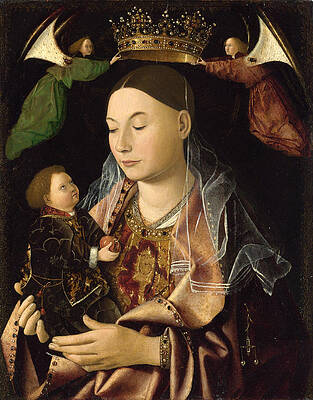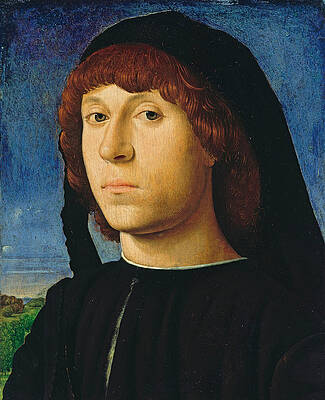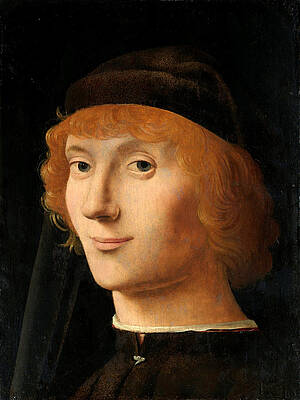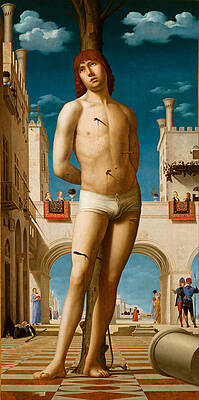Antonello da Messina
Paintings
The Virgin and Child
Portrait of a Young Man
Portrait of a Young Man 2
Christ Crucified
Christ Blessing
Portrait of a Man
Portrait of a Young Gentleman
St Sebastian
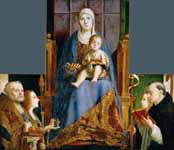
Madonna with Saint Nicholas of Bari
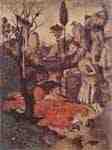

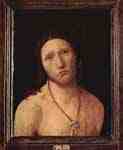
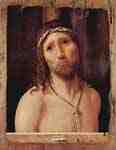

Appearance of three angels before Abraham , fragment

Sts . Nicholas and Mary Magdalene

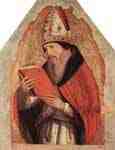

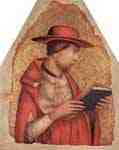
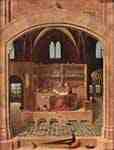


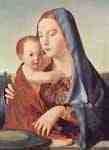
Madonna, so called Madonna Benson
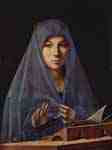

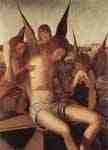
Pietà with three angels , fragment
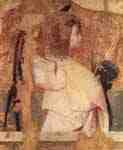
Polyptych of St. Gregory : Angel of the Annunciation , detail

Polyptych of St. Gregory : Annunciation

Polyptych of St. Gregory : St. Gregory

Polyptych of St. Gregory : Enthroned Madonna

Polyptych of St. Gregory : St. Benedict

Polyptych of St. Gregory : St. Benedict , detail
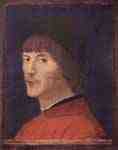
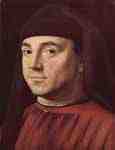

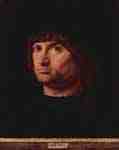
Portrait of a Man ( The Condottiere )

Portrait of a Man ( Trivuluzio di Milano ? )
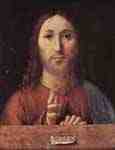

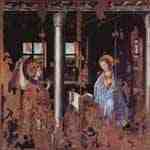
Drawings
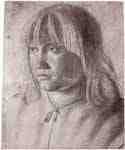
Fine Art Prints | Greeting Cards | Phone Cases | Lifestyle | Face Masks | Men's , Women' Apparel | Home Decor | jigsaw puzzles | Notebooks | Tapestries | ...
The Virgin and Child
Antonello da Messina, properly Antonello di Giovanni di Antonio, but also called Antonello degli Antoni (c. 1430 – February 1479), was an Italian painter from Messina, Sicily, active during the Italian Renaissance. His work shows strong influences from Early Netherlandish painting although there is no documentary evidence that he ever travelled beyond Italy. Giorgio Vasari mistakenly credited him with the introduction of oil-painting into Italy. Unusually for a south Italian artist, his work proved influential on painters in northern Italy, especially in Venice.
Biography
Early life and training
Antonello was born at Messina around 1429–1431, to Giovanni de Antonio Mazonus and Garita (Margherita).
According to a letter written in 1524 by the Neapolitan humanist Pietro Summonte, in about 1450 he was a pupil of the painter Niccolò Colantonio at Naples,[4] where Netherlandish painting was then fashionable. This account of his training is accepted by most art historians.[5]
Early career
Antonello returned from Naples to Messina at some time in the 1450s.[2] In around 1455 he painted the so-called Sibiu Crucifixion, inspired by Flemish treatments of the subject, which is now in the Muzeul de Artǎ in Bucharest. A Crucifixion in the Royal Museum of Antwerp dates from the same period. These early works shows a marked Flemish influence, which it is now understood he derived from his master Colantonio and from paintings by Rogier van der Weyden and Jan van Eyck that belonged to Colantonio's patron, Alfonso V of Aragon.
In his biography of the artist, Giorgio Vasari remarked that Antonello saw an oil painting by Jan Van Eyck (the "Lomellini Tryptych") belonging to King Alfonso V of Aragon at Naples. Another theory, supported only by vague documentary evidence, suggests that in 1456 Antonello visited Milan, where he might have met Van Eyck's most accomplished follower, Petrus Christus. Since Antonello was one of the first Italians to master Eyckian oil painting, and Christus was the first Netherlandish painter to learn Italian linear perspective, such a meeting would be a convenient explanation for the evolution of the styles of both artists, but in fact, neither is known for certain to have been in Milan at the time.
Antonello's earliest documented commission, in 1457, was for a banner for the Confraternità di San Michele dei Gerbini in Reggio Calabria, where he set up a workshop for the production of such banners and devotional images.[2] At this date, he was already married, and his son Jacobello had been born.
In 1460, his father is mentioned leasing a brigantine to bring back Antonello and his family from Amantea in Calabria. In that year, Antonello painted the so-called Salting Madonna, in which standard iconography and Flemish style are combined with a greater attention in the volumetric proportions of the figures, probably indicating a knowledge of works by Piero della Francesca. Also from around 1460 are two small panels depicting Abraham Served by the Angels and St. Jerome Penitent now in the Museo Nazionale della Magna Grecia in Reggio Calabria. In 1461 Antonello's younger brother Giordano entered his workshop, signing a three-year contract. In that year Antonello painted a Madonna with Child for the Messinese nobleman Giovanni Mirulla, now lost.
He probably painted his first portraits in the late 1460s. They follow a Netherlandish model, the subject being shown bust-length, against a dark background, full face or in three-quarter view,[6] while most previous Italian painters had adopted the medal-style profile pose for individual portraits.[7] John Pope-Hennessy described him as "the first Italian painter for whom the individual portrait was an art form in its own right".[8]
The Virgin Annunciate in the Palazzo Abatellis in Palermo
Although Antonello is mentioned in many documents between 1460 and 1465, establishing his presence in Messina in those years, a gap in the sources between 1465 and 1471 suggests that he may have spent these years on the mainland.[7] In 1474, he painted the Annunciation, now in Syracuse, and the St. Jerome in His Study also dates from around this time.[9]
Venice
He went to Venice in 1475, and remained there until the fall of 1476. His works of this period begin to show a greater attention to the human figure, regarding both anatomy and expressivity, indicating the influence of Piero della Francesca and Giovanni Bellini. His most famous pictures from this period include the Condottiere (Louvre), the San Cassiano Altarpiece and the St. Sebastian. The San Cassiano Altarpiece was especially influential on Venetian painters, as it was one of the first of the large compositions in the sacra conversazione format which was perfected by Giovanni Bellini (Antonello's surviving work in Vienna is only a fragment of a much larger original).
While in Venice he was offered, but did not accept, the opportunity to become the court portrait painter to the Duke of Milan.[10]
Return to Messina and death
Antonello had returned to Sicily by September 1476.[6] Works from near the end of his life include the famous Virgin Annunciate, now in the Palazzo Abatellis in Palermo, and the San Gregorio Polyptych.
He died at Messina in 1479: his testament dates from February of that year, and he is documented as no longer alive two months later. Some of his last works remained unfinished, but were completed by his son Jacobello.
Style and legacy
Antonello's style is remarkable for its union of Italian simplicity with Flemish concern for detail. He exercised an enormous influence on Italian painting, not only by the introduction of the Flemish invention, but also by the transmission of Flemish tendencies. However, no school of painting formed after his death, with the exception of the Sicilian Marco Costanzo.
Selected works
Sibiu Crucifixion (1455) - Muzeul de Artà, Bucharest
Crucifixion (1455) - Oil on panel 52.5 x 42.5 cm, Koninklijk Museum voor Schone Kunsten, Antwerp
Abraham Served by the Angels - Museo della Magna Grecia, Reggio Calabria
Ecce Homo (c. 1470) - Tempera and oil on panel, 42.5 x 30.5 cm, Metropolitan Museum of Art, New York City
Ecce Homo (1470) - Tempera and oil on panel, 40 x 33 cm, Galleria Nazionale di Palazzo Spinola, Genoa
St. Jerome Penitent - Various techniques on wood, 40.2 x 30.2 cm, Museo della Magna Grecia, Reggio Calabria
San Gregorio Polyptych (1473) - Tempera on panel, 194 x 202 cm, Regional Museum, Messina
Ecce Homo (c. 1473) - Tempera on panel, 19.5 x 14.3 cm, Private collection, New York City
Portrait of a Man (1474) - Oil on wood, Staatliche Museen, Berlin
Madonna with Child (Salting Madonna) - Oil on wood, 43.2 x 34.3 cm, National Gallery, London
Portrait of a Man (1474) - Oil on wood, 32 x 26 cm, Staatliche Museen, Berlin
Annunciation (1474) - Oil on panel, 180 x 180 cm, Museum of Palazzo Bellomo, Syracuse
St. Jerome in His Study (c. 1474) - Oil on wood, 46 x 36,5 cm, National Gallery, London
Ecce Homo (1475) - Oil on panel, 48.5 x 38 cm, Collegio Alberoni, Piacenza
Portrait of a Man (Il Condottiere) (1475) - Oil on wood, 35 x 38 cm, Musée du Louvre, Paris
Crucifixion (1475) - Wood, 42 x 25,5 cm, National Gallery, London
Portrait of a Man (c. 1475) - Oil on wood, Galleria Borghese, Rome
Portrait of a Man (c. 1475) - Oil on panel, 36 x 25 cm, National Gallery, London
Portrait of a Man (1475–1476) - Oil on panel, 28 x 21 cm, Museo Thyssen-Bornemisza, Madrid
San Cassiano Altarpiece (1475–76) - Oil on panel, Kunsthistorisches Museum, Vienna
The Dead Christ Supported by an Angel (1475–78) - Panel, 74 x 51 cm, Museo del Prado, Madrid
Christ at the Column (c. 1475–1479) - Oil on wood, 25,8 x 21 cm, Musée du Louvre, Paris
Virgin of the Annunciation -Oil on panel, Alte Pinakothek, Munich
Portrait of a Man (1476) - Oil on panel, Museo Civico d'Arte Antica, Turin
Virgin of the Annunciation (c. 1476) - Oil on wood, 45 x 34,5 cm, Museo Nazionale, Palermo
St. Sebastian (1477–1479) - Oil on canvas transferred from panel, 171 × 85 cm, Gemäldegalerie Alte Meister, Dresden
Portrait of a Young Man (c. 1478) - Panel, 20.4 x 14.5 cm, Staatliche Museen, Berlin
Portrait of an unknown man - Oil on panel, Museo Mandralisca, Cefalu
References
Memorie istorico-critiche di Antonello degli Antonj pittore Messinese], by Tommaso Puccini, Florence 1809.
Barbera 2005, p. 13.
Barbera 2005, p. 14.
The letter to the Venetian Marcantonio Michiel, of 20 March 1524, reporting on the state of art in Naples, and works there by Netherlandish painters, dwells upon Colantonio and his Netherlandish technique, which one sees assimilated in the art of Antonello; it was published by Fausto Niccolini, L'arte napoletana del Rinascimento (Naples) 1925:161-63. It is translated in Carol M. Richardson, Kim Woods and Michael W. Franklin, Renaissance Art Reconsidered: An Anthology of Primary Sources (2007:193-96).
Barbera 2005, p. 15.
Barbera 2005, p. 23.
Barbera 2005, p. 51.
Pope-Hennessy 1966, p. 60.
Barbera 2005, p. 22.
Barbera 2005, p. 29.
Sources
Barbera, Giocchino (2005). Antonello da Messina, Sicily's Renaissance Master (exhibition catalogue). New York: Metropolitan Museum of Art Yale University Press. ISBN 0-300-11648-9 (online).
Pope-Hennessy, John (1966). The Portrait in the Renaissance. London: Phaidon.
Public Domain This article incorporates text from a publication now in the public domain: Chisholm, Hugh, ed. (1911). Encyclopædia Britannica (11th ed.). Cambridge University Press.
----
Fine Art Prints | Greeting Cards | Phone Cases | Lifestyle | Face Masks | Men's , Women' Apparel | Home Decor | jigsaw puzzles | Notebooks | Tapestries | ...
----
Artist
A - B - C - D - E - F - G - H - I - J - K - L - M -
N - O - P - Q - R - S - T - U - V - W - X - Y - Z
Retrieved from "http://en.wikipedia.org/"
All text is available under the terms of the GNU Free Documentation License


